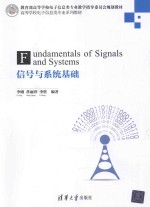

信号与系统基础PDF电子书下载
- 电子书积分:10 积分如何计算积分?
- 作 者:李刚,常丽萍,李胜编著
- 出 版 社:北京:清华大学出版社
- 出版年份:2015
- ISBN:9787302385981
- 页数:246 页
Chapter 1 Introduction 1
1.1 Overview of signals and systems 1
1.1.1 What is a signal? 1
1.1.2 What is a system? 2
1.2 Description and classification of signals 5
1.2.1 Continuous-time signals and discrete-time signals 6
1.2.2 Energy signals and power signals 9
1.2.3 Periodic signals and non-periodic signals 11
1.2.4 Deterministic signals and random signals 14
1.2.5 Elementary signals 15
1.3 Description of Systems 22
1.3.1 Elementary systems 22
1.3.2 System modelling 26
1.4 Properties of systems 29
1.4.1 Memoryless and with memory 29
1.4.2 Causality 30
1.4.3 Invertibility 30
1.4.4 Stability 31
1.4.5 Time-invariance 33
1.4.6 Linearity 34
1.5 Summary 37
1.6 Problems 37
Chapter 2 Time-domain Analysis of LTI Systems 43
2.1 Introduction 43
2.2 The unit impulse response and convolutions 43
2.2.1 The convolution sum 45
2.2.2 The convolution integral 49
2.3 Properties of convolutions and equivalent systems 51
2.4 Causality and stability of LTI systems 56
2.5 Systems constrained with LCCDEs 59
2.5.1 Continuous-time systems constrained with LCCDEs 59
2.5.2 Discrete-time systems characterized by LCCDEs 62
2.6 Summary 64
2.7 Problems 65
Chapter 3 Fourier Analysis of Signals 69
3.1 Introduction 69
3.2 Fourier series for continuous-time periodic signals 70
3.3 Fourier series for discrete-time periodic signals 80
3.4 Why should a signal be transformed? 84
3.5 Fourier transform for continuous-time signals 87
3.5.1 Properties of Fourier transform 92
3.5.2 Inverse Fourier transform 100
3.6 The discrete-time Fourier transform 101
3.6.1 Properties of DTFT 106
3.6.2 Inverse DTFT 109
3.7 Fourier series and Fourier transforms 110
3.8 Summary 114
3.9 Problems 115
Chapter 4 Frequency-domain Approach to LTI Systems 121
4.1 Introduction 121
4.2 Frequency response of LTI systems 121
4.3 Bode plots for continuous-time LTI systems 127
4.4 Frequency response of LTIs described with LCCDEs 130
4.5 Frequency domain approach to system outputs 135
4.6 Some typical LTI systems 138
4.6.1 All-pass systems 138
4.6.2 Linear phase response systems 139
4.6.3 Ideal filters 140
4.6.4 Ideal transmission channels 143
4.7 Summary 145
4.8 Problems 146
Chapter 5 Discrete Processing of Analog Signals 149
5.1 Introduction 149
5.2 Sampling of a continuous-time signal 150
5.3 Spectral relationship and sampling theorem 150
5.4 Reconstruction of continuous-time signals 154
5.5 Hybrid systems for discrete processing 159
5.6 Discrete Fourier transform 160
5.7 Compressed sensing 164
5.8 Summary 165
5.9 Problems 166
Chapter 6 Transform-domain Approaches 169
6.1 Motivation 169
6.2 The Laplace transform 169
6.2.1 Derivation of the transform 169
6.2.2 Region of convergence 171
6.2.3 Inverse Laplace transform 176
6.2.4 Properties of Laplace transform 178
6.3 The z-transform 179
6.3.1 Region of convergence 180
6.3.2 Properties of the z-transform 184
6.3.3 Inverse z-transform 186
6.4 Transform-domain approach to LTI systems 187
6.4.1 Transfer function of LTI systems 188
6.4.2 Inverse systems of LTIs and deconvolutions 190
6.4.3 Revisit of LTI system's stability and causality 192
6.4.4 Transfer function of LTI systems by LCCDEs 195
6.5 Transform domain approach to LCCDEs 197
6.6 Decomposition of LTI system responses 200
6.7 Unilateral transforms 202
6.7.1 Unilateral Laplace transform 203
6.7.2 Unilateral z-transform 205
6.8 Summary 207
6.9 Problems 207
Chapter 7 Structures and State-space Realizations 212
7.1 Block-diagram representation 212
7.2 Structures of LTIs with a rational transfer function 214
7.3 State-space variable representation 219
7.3.1 State model and state-space realizations 219
7.3.2 Construction of an equivalent state-space realization 221
7.3.3 Similarity transformations 222
7.4 Discretizing a continuous-time state model 224
7.5 Summary 227
7.6 Problems 228
Chapter 8 Comprehensive Problems 231
8.1 Motivation 231
8.2 Problems 231
Appendices 237
Bibliography 246
- 《市政工程基础》杨岚编著 2009
- 《零基础学会素描》王金著 2019
- 《计算机网络与通信基础》谢雨飞,田启川编著 2019
- 《管理信息系统习题集》郭晓军 2016
- 《生物质甘油共气化制氢基础研究》赵丽霞 2019
- 《花时间 我的第一堂花艺课 插花基础技法篇》(日)花时间编辑部编;陈洁责编;冯莹莹译 2020
- 《Photoshop CC 2018基础教程》温培利,付华编著 2019
- 《信息系统安全技术管理策略 信息安全经济学视角》赵柳榕著 2020
- 《看视频零基础学英语口语》宋德伟 2019
- 《胃癌基础病理》(日)塚本彻哉编者;宫健,刘石译者 2019
- 《市政工程基础》杨岚编著 2009
- 《家畜百宝 猪、牛、羊、鸡的综合利用》山西省商业厅组织技术处编著 1959
- 《《道德经》200句》崇贤书院编著 2018
- 《高级英语阅读与听说教程》刘秀梅编著 2019
- 《计算机网络与通信基础》谢雨飞,田启川编著 2019
- 《看图自学吉他弹唱教程》陈飞编著 2019
- 《法语词汇认知联想记忆法》刘莲编著 2020
- 《培智学校义务教育实验教科书教师教学用书 生活适应 二年级 上》人民教育出版社,课程教材研究所,特殊教育课程教材研究中心编著 2019
- 《国家社科基金项目申报规范 技巧与案例 第3版 2020》文传浩,夏宇编著 2019
- 《流体力学》张扬军,彭杰,诸葛伟林编著 2019
- 《大学计算机实验指导及习题解答》曹成志,宋长龙 2019
- 《指向核心素养 北京十一学校名师教学设计 英语 七年级 上 配人教版》周志英总主编 2019
- 《大学生心理健康与人生发展》王琳责任编辑;(中国)肖宇 2019
- 《大学英语四级考试全真试题 标准模拟 四级》汪开虎主编 2012
- 《大学英语教学的跨文化交际视角研究与创新发展》许丽云,刘枫,尚利明著 2020
- 《北京生态环境保护》《北京环境保护丛书》编委会编著 2018
- 《复旦大学新闻学院教授学术丛书 新闻实务随想录》刘海贵 2019
- 《大学英语综合教程 1》王佃春,骆敏主编 2015
- 《大学物理简明教程 下 第2版》施卫主编 2020
- 《指向核心素养 北京十一学校名师教学设计 英语 九年级 上 配人教版》周志英总主编 2019
